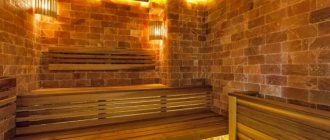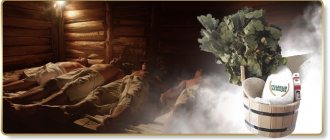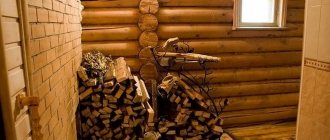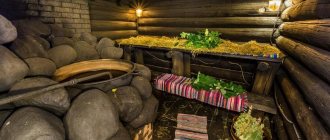Photo: Andrey Shchekalev, shutterstock (09/1/2019) Today, saunas, hammams and other types of similar establishments are being built to replace archaic steam rooms. But no matter how many such varieties are invented, the Russian bathhouse will never lose its popularity and demand among hot lovers. Russian bathhouse is a brand.
What is a Russian bathhouse
A unique symbiosis of several elements at once: air, earth, fire and water. In addition to the fact that this is a place for taking hygiene procedures, it provides an opportunity to relax the body and spirit, and carry out a whole range of wellness procedures.
If you believe history, then the bathhouse has always existed in Rus'. According to legends, it was a log building with a fireplace, and the guardian of the bathhouse and its soul was a naked old man - a bannik.
Chronicles of the X–XIII centuries. they talk about how common baths were among the Eastern Slavs in the 5th–6th centuries, how affectionately they called them mylnya or movnitsa. With the Baptism of Rus', the bathhouse strengthened its influence, as it became a place for mandatory visiting before performing important church rituals.
Signs of the third millennium
Traditions are traditions, and modern man is accustomed to comfort. Moreover, current technologies allow you to surround yourself with a mass of all kinds of conveniences in all areas of life, including in the field of bath procedures.
For example, if you are tired of taking a steam bath in a Russian bath, you can easily switch to the Turkish hammam mode by setting the appropriate parameters: 100% humidity at a temperature of 35–50°C. To do this, you will need a steam generator installed in a separate room and connected to the steam room by a special pipeline. In addition, if you have a steam generator, the bathhouse can also be used as a biosauna; you just need to place the herbal mixtures in a special container with a mesh bag (steam column). And if you install dispensers for dry and liquid flavors in a Russian bath, the bath procedure will be complemented by an aromatherapy session. Moreover, automated sprayers operate silently and are controlled from a single remote panel. In addition to herbal and aromatherapy, there is also light, color and sound therapy, which also has a beneficial effect on the psycho-emotional sphere of a person.
Oxytherapy has also been added to the list of health-improving functions of a modern bathhouse - inhaling oxygen while steaming through a special mouthpiece. This energizes you, improves brain efficiency and your ability to cope with physical activity. You can expand the scenario of the bath ritual by adding to it, along with hot and cold water baths, other interesting objects, for example, an ice well, a snow grotto, a steam glass cabin. Thanks to all these and many other innovations, the Russian bathhouse today is a multidimensional, diverse world, comparable to large spa complexes in terms of the effectiveness of a person’s physical and mental health.
And finally, we cannot fail to mention modern building materials, which significantly speed up the process of constructing a bathhouse and make it possible to implement almost any design solutions.
Now remember an old village bathhouse somewhere in the Russian outback and imagine a modern one that you can put in your summer cottage. Which one will you choose? Definitely modern with a Russian spirit.
Rules for taking a bath and preparing for it
For the bath to be beneficial, it is enough to follow a few basic rules:
- Do not drink alcohol both while in the steam room and before visiting it;
- Don’t overeat (you shouldn’t go hungry either, you can get by with a light snack);
- Monitor your condition and do not force yourself to sit in the steam room;
- You can enter the steam room several times, each entry will differ from the other in thermal conditions and duration;
- You should stay in the bathhouse for no more than 25 minutes.
Before visiting you must:
- Douse yourself with warm water or take a shower to prepare your body for higher temperatures.
- To preserve the lipid layer of the skin, which performs a barrier function, you need to refrain from using soap with a washcloth.
- Do not get your hair wet, this will protect you from heat stroke. It is better to put on a hat made of wool or linen, after wetting it.
You need to hit the skin with a bath broom
Brooms in the bathhouse are used for two purposes: firstly, with their help they “adjust” hot air to the skin and delicately massage its surface, and secondly, they obtain aqueous extracts of biologically active substances, which are then splashed onto hot stones to create healing steam . For steaming, brooms are usually used from branches of deciduous trees: birch, oak, linden, eucalyptus, aspen, as well as medicinal herbs. For inhalation, brooms made from coniferous plants are also steamed.
To forcefully whip a broom over the body is completely useless, and even unsafe, since you can injure the surface layer of the skin, softened by the heat.
How to steam properly
The first entry into the steam room is required
to warm up and get used to the heat load (optimum temperature 60°C). A broom is not needed at this stage. It is better to lie on the bottom shelf; at this level the temperature necessary for adaptation is maintained. When the skin turns red, sweat appears and the heart beats faster, you can climb to the top bunk. The duration of the first approach should not exceed 10 minutes.
The second visit can last 15 minutes
and accompanied by a broom massage:
- Plowing - swinging a broom towards the steamer, then shaking it under the ceiling of the steam room and briefly pressing the hot branches to the lower back, feet, and shoulder blades.
- Whipping on the skin and slowly stroking the body with a broom.
- Compress - lowering a broom onto the body with firm pressure for 5 seconds. At the end of the massage, you should not get up suddenly, it is better to lie down for a few minutes, then, without rushing to get up.
Steaming with a broom
A broom in a steam room is one of the main accessories - it can not only give you a good whipping, but also act as a medicine.
- A birch broom will rid the skin of toxins and remove salt from the body. It is recommended for use by people with kidney and musculoskeletal diseases.
- Oak - stabilizes blood pressure. Oak leaves have anti-inflammatory properties, calm the nervous system and help with headaches and insomnia.
- Linden broom contains vitamin C. It is used as an antipyretic and to calm the nerves.
- Fir - eliminates pain in muscles and spine, improves immunity. It has disinfecting and bactericidal properties.
- Juniper broom contains natural antibiotics, prevents the appearance of bacteria and reduces high fever.
Few people know how useful a broom made from nettle branches is. Even with a light touch, it creates a deep massage of the skin with a tingling effect, which improves its elasticity and firmness. The skin additionally warms up, turns red, and blood flow improves.
Nettle is useful for kidney and liver diseases, strengthens the walls of blood vessels. Only problem areas are hovered with such a broom, applied for a while to the sore spots.
Sauna for weight loss
A Russian bath is an excellent assistant in losing weight, because at high temperatures sweat is actively released, along with toxins, salts and other harmful substances, but it is important to understand that fat reserves are not destroyed. Going to the bathhouse is regarded as an auxiliary method for losing weight, but not the main one.
Photo: Juliya Shangarey, shutterstock (1.09.2019)
The bath accelerates blood circulation, which increases the flow of oxygen and nutrients to the internal organs. You can forget about cellulite and improve your skin condition. Heating causes an acceleration of metabolism.
To achieve the desired effect, you must follow the rules:
- Before entering the steam room, take a warm shower, but without using soap or a washcloth.
- Add infusions of aromatic herbs or essential oils to the water that creates steam.
- The first visit to the steam room should not exceed 5 minutes. After it, you need to go out, rinse with cold water, throw on a sheet and rest. You can drink a drink to increase sweating.
- On the second visit, you should use a broom; your stay in the steam room will also be about 5 minutes.
- Next time, you can simply sit on a shelf, rub your body with gentle movements using a broom and rub yourself with honey or salt.
- Compliance with temperature contrasts: the higher the temperature, the colder the water for dousing should be.
Similar articles
Black Himalayan salt for health (uses and properties of sanchal)
2019-07-16
Peppermint essential oil: what are its beneficial properties?
2019-03-28
You can also use scrubs and various masks.
Steaming when you have a cold
If you have a cold, a Russian bath will speed up recovery due to the effects of high temperature and increased moisture.
- Wet steam performs the function of inhalation, ensuring the cleansing of the lungs and bronchi from accumulated mucus.
- Hot steam opens and cleanses pores.
- Increased humidity will relieve muscle tension and fatigue, and also strengthen joints and ligaments.
What and how to serve in the steam room
Herbal infusions not only give a pleasant smell, but also have a beneficial effect on the body. The heated essential molecules of plants increase their activity many times over, thanks to which we leave the steam room literally imbued with benefits.
For example, eucalyptus steam contains 40 beneficial components. Peppermint improves mood and calms nerves. Linden greatly enhances sweating and treats colds. There are lovers of beer, kvass and even tobacco vapor. Cigarette smoke is harmful to health, but brewed tobacco heals problem skin.
First, hot water is splashed on the stones to cool them slightly. Then - the diluted infusion, and then - water again. You can also sprinkle the infusion on the walls and floor. But you should not water those present - when mixed with sweat, it will give off an unpleasant odor.
Who shouldn't go to the bathhouse?
Reasons for temporarily abstaining from baths:
- Cold with high fever;
- Aggravated chronic diseases;
- Regular headaches;
- Thrombophlebitis;
- Hypertension stages I and II;
- Unstable angina;
Absolute ban:
- myocardial infarction;
- Stage III hypertension;
- acute inflammation of the cardiovascular system;
- acute thrombophlebitis;
- general atherosclerosis;
- frequent bleeding.
Nourishing skin masks should be applied between visits to the steam room.
The basis of almost all nourishing masks is fat. They create a film on the skin that closes the pores, so you cannot apply masks to the body and face before visiting the steam room: sweating is impaired. In addition, cosmetics of this kind contain aromatic substances that create foreign odors in the steam room.
Before taking bath procedures, you need to rinse with warm water in the shower and wipe your skin dry with a towel. In the steam room, you can use only peeling products to facilitate the exfoliation of dead skin particles. The process can be enhanced with honey: it has not only cleansing, but also nutritional properties. The rest of the cosmetics can be applied to the face and body only after completing the bath procedures.
Sauna – a modern version of the Russian steam room?
Unfortunately, in the second half of the 20th century, the words Russian bath and Finnish sauna began to be perceived by many as synonymous words. The thing is that in the 60s of the last century, a commercial bathhouse project was created in Finland, which was compact and electric.
The ease of installation and small dimensions of the electric oven have made it mega-popular. By the way, such saunas could be installed not only in private houses, but also in apartments.
Such dry-air saunas began to be installed by hotel owners and... go for export! Although the Finns themselves consider electric saunas a product for poor people. And of course, they have nothing in common with the Russian bathhouse. And the whole point is this.
Initially, they did not yet know how to insulate electric heating elements, so pouring water on them could result in a fairly noticeable electric shock. But since manufacturers of electric sauna stoves had to look for new markets for their products, a legend was invented about the life-giving power of dry steam, which cannot even be called steam.
That is why pouring water on stones in newfangled saunas of the second half of the last century was strictly prohibited. And if there is no steam, then what kind of Russian bath is it?
A bathhouse in which the air temperature reaches 120C° and the humidity is no more than 10% is not associated with the “light steam” for which our native steam room is so famous. If you splash water on the stones in such heat, you get a burning thick fog that burns your hands, skin and lungs.
But before, Finnish and Russian steam rooms were twin sisters, who developed in parallel directions and were as similar to each other as two peas in a pod.
You can cool your body in the pool after each steam bath.
Contrasting bath procedures (immersions in cold water or snow rubdowns, alternating with visits to the steam room) are very beneficial for the nervous system: they perfectly relieve stress. However, for other purposes they may be superfluous. If the point of the procedures is to restore strength after an illness, you should abandon temperature contrasts and take a hot shower between visits to the steam room.
But even when contrast procedures are indicated, experts recommend plunging into cold water only after the third steam bath, when the body is already evenly warmed up.
Historical facts
The history of the bathhouse dates back to Ancient Egypt, Greece and the Great Roman Empire.
It is known that ancient Greek baths were available to people of wealth and the poor. For the ancient Greeks, the bathhouse served as a hospital.
For the Romans, bath life was a real art. Here they sang, read poetry, and had leisurely conversations. The baths were like unique museums with fountains, sculptures and marble columns. Bath accessories were silver and gold. But after the collapse of the Roman Empire, their luxurious bath history died.
With the flourishing of Islamic culture, the history of oriental baths began. They are still thriving. The hammam was visited frequently, as was the mosque. The history of the Turkish bath has not died or changed over the years. She still maintains her principles.
This may seem strange, but the spread of Christianity and the enormous influence of the church killed baths and bath culture in Western Europe. The Catholic Church considered the bath a huge sin.










